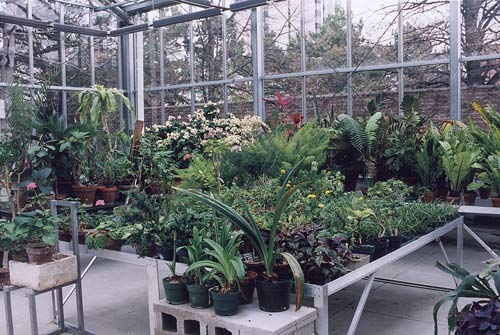Conifers are shady all the year around, but on the plus side, they do make a good windbreak in an exposed site. They are also less likely to drop bits onto your greenhouse, although bear in mind that all trees lose their leaves and twigs at some time or other.
Don't take the idea of an 'open' site too literally, however. Greenhouses cannot withstand the full blast of winter storms, nor endless strong winds, which also have a detrimental cooling effect. If your site is particularly exposed, consider erecting (or growing) a windbreak on the windy side. This is usually the south-west side, since this is where the prevailing weather comes from, but bear in mind that northern and eastern winds are much colder and will have a much stronger influence on conditions inside your greenhouse in winter. If you think you might need a windbreak, position it to give your greenhouse the most efficient shelter possible.
The best windbreaks are those that slow the wind, rather than blocking it
altogether. This means that hedges are most suitable, while fences with an open structure are more likely to be successful than close-boarded varieties, such as larch lap. With the latter, you may end up tunnelling the wind through a narrow space, which will increase its strength, or creating turbulence on the lee side of the fence, just where your greenhouse is.
Frost pockets
It makes sense to avoid putting your greenhouse in or anywhere near a frost pocket. If you aren't sure whether your garden has any, take a look around it on a frosty day. The coldest places are where the ground stays white and frozen longer than anywhere else.
Hot air rises and cold air sinks, so in a sloping garden the low-lying areas get much colder than those higher up. Where the co d air is trapped by hedges or buildings, the area will stay colder for longer, too. If you must position your greenhouse in such a spot, you might be able to improve matters by making gaps in hedges or fences, which will allow the cold air to flow on down the hill.
Shelter
An open site is most suitable, or as open as you can manage; keep 10m (30ft) from any substantial trees if at all possible. This is not only because of the shade they might cast, but also because they shed leaves and twigs, which can cause damage and will certainly block gutters and increase the frequency with which you have to clean the glass. Some trees, particularly limes, are hosts to pests that drop sticky honeydew onto whatever is below them; this encourages moulds to grow — again, something to be avoided if possible.
You can visit this flower guide for more information about this article.

No comments:
Post a Comment